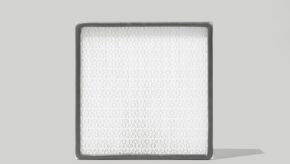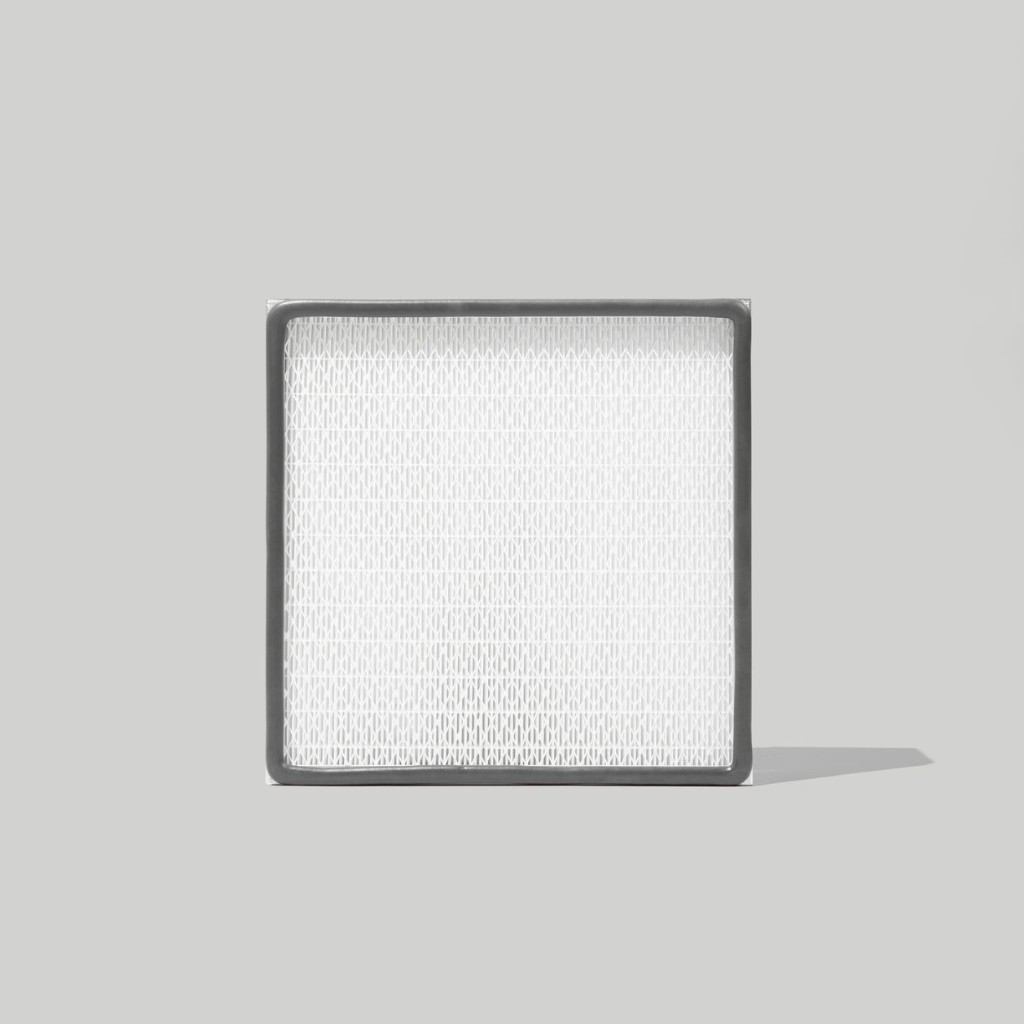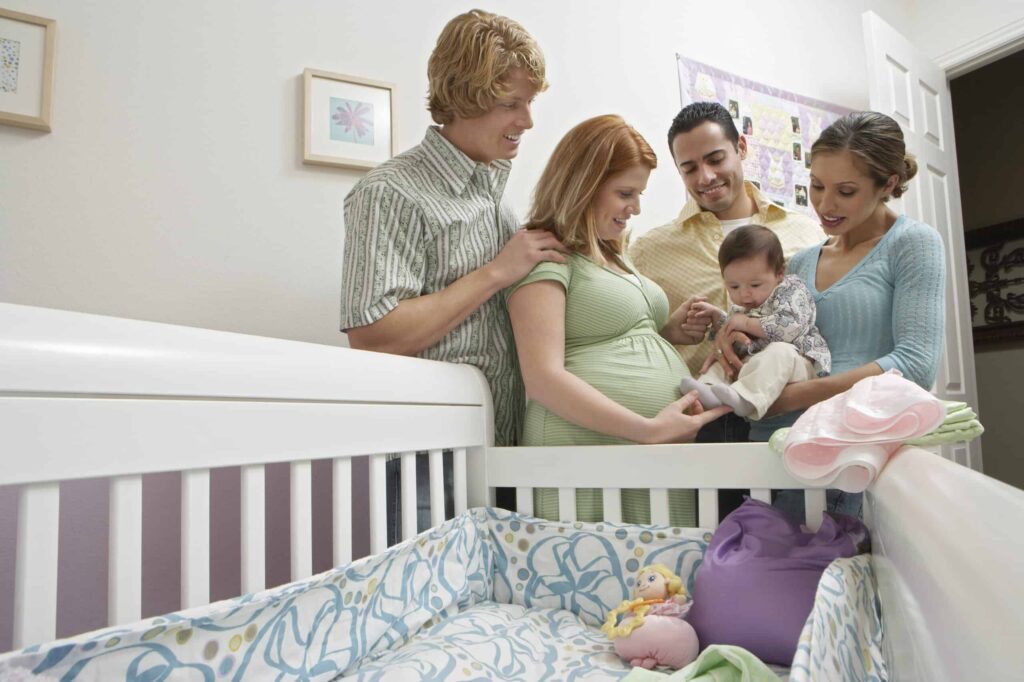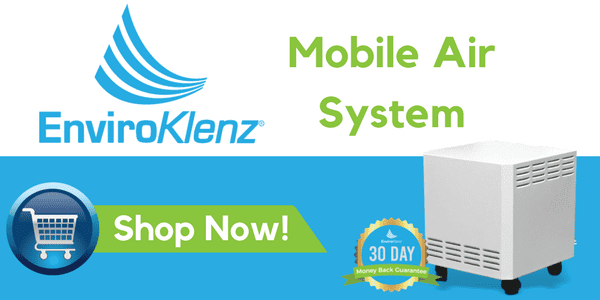Baby’s Health is Affected by Indoor Air Quality
A child’s health is of utmost importance to any parent. There are several factors that have an impact on a baby’s well-being, including nutrition, proper attention from caretakers, and medical care. While these more obvious needs are most often met, sometimes other threats to an infant’s health are overlooked. One major hazard to a child’s health that is often overlooked is their indoor environment and the air that they are being exposed to on a daily basis.
Nurseries and child play areas in the home tend to have high concentrations of airborne chemicals and pollution more commonly referred to as volatile organic compounds or “VOC’s”. Surprisingly, many of these hazardous substances come from products that we introduce to our homes such as new furniture, new flooring, paint, and clothing designed specifically for babies. In a study conducted by the Greenguard Environmental Institute and aired by “Good Morning America,” air tested inside of a nursery contained over 300 chemicals, compared to only 2 right outside the window.
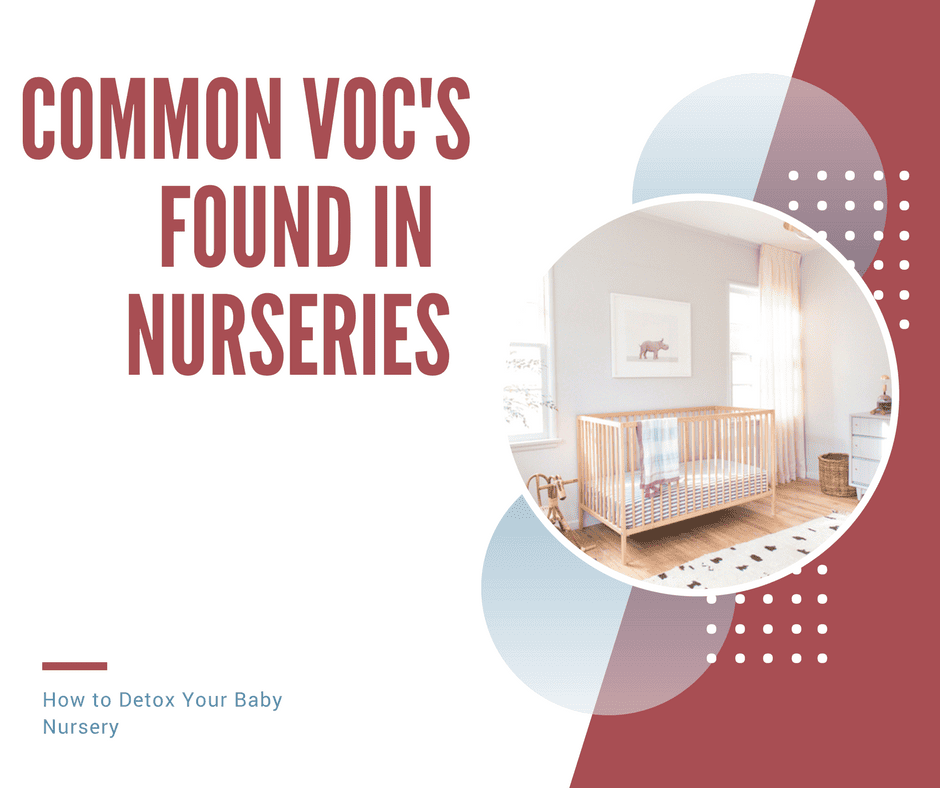
This study tested the air alone but indicated that many of the toxins were emitted from items like crib mattresses, rocking chairs, and paint. These toxins are hazardous to both adults and well as children. However, children are doubly at risk in these environments because 1) their immune systems work differently from those of adults, and they inhale a larger proportion of air per pound than adults do, and 2) because they tend to spend time playing on the floor or putting things in their mouths, which leads to even more exposure to any toxins present.
While there is not extensive information about the effects of ingesting these chemicals and how they manifest later on in life, we do know that there is a link between breathing in these toxins and certain diseases. The following are just a few examples of disorders shown to be correlated in some way with exposure to hazardous chemicals:
• Asthma
• Cancer
• Diabetes
• Childhood obesity
• Autism
• Birth defects
Although the opinion among medical professionals varies, it is thought that between 1 to 10 percent of these conditions can be blamed to some degree on exposure to VOCs. Some claim that as many as 30 percents of childhood asthma cases can be attributed to allergens, pollutants, and hazardous toxic airborne chemicals. Chemical exposure becomes a danger to babies even before they are born. Mothers who are chronically exposed to toxic chemicals can pass them on to the fetus, transferring the risk of some of these medical conditions to them as well.
With this evidence of the dangerous levels of toxins present in baby’s and children’s rooms, it is clear that a baby’s health can be quite negatively affected by poor indoor air quality.
Chemical Hazards Found in Baby Nurseries
The chemicals found in studies of air quality in nurseries are alarming, and of cause for concern. Some known poisons found include:
• Formaldehyde
• Lead
• Flame retardants
• Parabens
These are just some of the hundreds of dangerous chemicals present in the nursery.
Where do these chemicals come from? Nurseries are filled with products marketed especially toward children, which are actually adding more pollutants and even carcinogens to your child’s environment.
In her article “A Safe Place: Chemical-Free Baby’s Room,” Ann Campbell reviews some very common items purchased for baby’s rooms, and why they are dangerous. For example, new carpets alone emit more than 120 chemicals into the air. This is in part due to the adhesive used, fire retardants use on carpeting, as well as the synthetic fibers that make up the carpet. Common chemicals found in new carpeting include formaldehyde, acetaldehyde, and benzene, all which can cause headaches, nose, and throat irritation.Babies are particularly susceptible to toxins in carpet because they spend more time on the ground.
New furniture such as rocking chairs also poses a risk, especially those that are recently painted or varnished. Fumes from varnish can release toxins like formaldehyde into the air. The more recent a piece of furniture has been refinished or painted, the stronger the chemicals and the greater the risk. Placing a recently purchased piece of furniture outside to cure in the sun can help lower the strength of harmful toxins, but not get rid of them completely. Even furniture made of plastic can contain unsafe chemicals.
If you have ever walked into a freshly painted room, you have likely noticed the strong smell that lingers. Perhaps you have gotten a headache after spending a day painting. The odors of paint often contain volatile organic chemicals (VOC’s). These result from the solvents in the paint being dissolved into the air. They can stay in the surrounding air for months or years after the last coat of paint is put on. Paint can contain toxins like lead, benzene, styrene, and toluene, which are known to cause harm to the central nervous system and hinder fetal development.
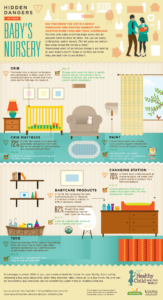
Via-healthy Child
New baby clothing can also contribute to the danger. Baby and children’s clothing often contain synthetic materials such as acrylic fibers that are a form of plastic, which emit certain harmful chemicals. Baby clothing is often made with chemical finishes such as formaldehyde to prevent staining, or flame retardants to protect children in case of fire. While clothing that has repeatedly been washed will have a much smaller concentration of toxins, they may still be present. Clothing made from natural materials such as cotton or wool are preferable, as they have a much lower degree of added chemicals.
With toxins found in all of these items, parents may think twice about remodeling a baby’s room before they arrive, or purchasing all new furniture and clothing. Toxins lurk in more places than we realize, especially in products that are purchased brand new.
Common VOCs Found in Nurseries
As mentioned previously, VOC’s are organic compounds that are airborne. Many are found naturally, such as carbon, hydrogen, or oxygen, which are found in the air everywhere, and are not dangerous. Others, such as those emitted from paint solvents or other chemicals, are hazardous air pollutants that can cause potentially harmful effects on our health.
Unfortunately, many VOC’s can be found in a nursery. Some of the most dangerous VOC’s in nurseries that show up most frequently include:
• Phthalates
• Organophosphate flame retardants
• Biocides
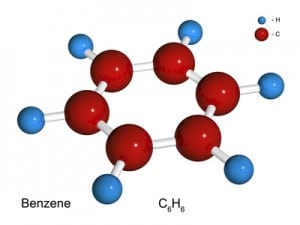
Phthalates are estrogen-mimicking chemicals that can be found in sources varying from caulking and wood fillers, to PVC pipes, to some crib mattresses. They are also used commonly in many construction materials. They can be harmful both to a developing fetus and to children and have been shown to cause liver cancer.
Many flame retardants are dangerous, but organophosphate flame retardants are particularly toxic. They are found in polyurethane foam, which is used in memory foam mattresses, building insulation, foam joints, and weather-stripping. This type of flame retardant can cause several types of cancer.
Biocides are chemicals designed to kill or deter insects or other pests. They include pesticides used to get rid of bugs or animals. Antimicrobial chemicals are also classified as biocides. Many baby products are made with anti-mildew, antifungal, or antimicrobial biocide chemicals in an attempt to keep them germ-free and stay in good condition under regular wear-and-tear. Certain biocides can cause more harm than good, however. Many are classified as carcinogens and can cause other disorders, such as asthma.
Creating a Chemical-Free Nursery
Just because nurseries and children’s rooms have the potential to harbor many chemical pollutants does not mean that you have no choice but to expose your baby to them. You can take several measures to help you create a safe, non-toxic environment for your child.
 One important factor is timing. If at all possible, try to complete any painting, carpet installation, or other remodeling projects where paint or varnish will be involved either before becoming pregnant or at least 6 months before baby arrives to allow as much time as possible for harmful fumes to dissipate. To speed up the process, you should provide adequate ventilation by opening windows and turning on fans to flush the toxins out. Pregnant women should not be exposed at all to toxins found in these products, and should not participate in painting or staining of the baby’s room. A good rule of thumb is that you should wait until you can no longer smell any chemical fumes before allowing your child or a pregnant woman to return to the space.
One important factor is timing. If at all possible, try to complete any painting, carpet installation, or other remodeling projects where paint or varnish will be involved either before becoming pregnant or at least 6 months before baby arrives to allow as much time as possible for harmful fumes to dissipate. To speed up the process, you should provide adequate ventilation by opening windows and turning on fans to flush the toxins out. Pregnant women should not be exposed at all to toxins found in these products, and should not participate in painting or staining of the baby’s room. A good rule of thumb is that you should wait until you can no longer smell any chemical fumes before allowing your child or a pregnant woman to return to the space.
Pay attention to the products that you are using in the nursery. Many paints now are advertised as containing lower levels of contaminants or VOC’s. Paints labeled as “0 VOC’s” are less toxic than those that say “No VOC’s.” You can also contact the manufacturer of a specific paint to get a more detailed list of what chemicals are present. Regardless of whether you decide to paint the room or not, if your home was built before 1978, you should have the paint tested to make sure it does not contain lead, which can result in cognitive disorders if ingested in large quantities.
Flooring choices and timing are also important. Try to avoid installing new carpet if possible. A safer flooring option is hardwood floors with an area rug, which does not have the same chemical-emitting adhesive as wall-to-wall carpet. If you are refinishing hardwood floors in the nursery, follow the same precautions as with paint. Make sure there is plenty of ventilation. Do not allow your child or a pregnant woman to be in the room until the smell of the fumes is no longer detectable. That means the floor has “cured” and there is no longer a high concentration of chemicals present. Natural linoleum or bamboo flooring can also be good non-toxic flooring options.
When planning your baby’s wardrobe, consider hand-me-downs or clothing made from all natural fibers such as cotton or wool. Hand-me-downs, even if made from toxin-harboring synthetic materials, have usually been washed a sufficient number of times to get rid of the majority of harmful chemicals. As noted before, check the labels on new clothes. Even if something says it is 100% cotton, it could be coated with a toxic substance such as formaldehyde or a flame-retardant. For new baby clothing that is gifted to you or that you purchase, you can safely remove the chemical odors and malodor by using our EnviroKlenz laundry additive.
Baby furniture or bedding can also be laden with cancer or asthma-causing chemicals. Opt for natural wood furniture rather than pieces that have been varnished or stained. If you do go with stained wood furniture, check with the manufacturer if the sealant used was low or non-toxic. Mattresses made of foam should be avoided. Instead, look for mattresses and bedding made of organic, natural materials like cotton.
Is Your Baby’s Furniture Off-Gassing?

Off-gassing occurs when chemicals or toxins are emitted into the air. This often happens when new furniture or bedding is brought home. Many pieces of new furniture are kept wrapped in plastic or tightly bound in some other packaging material, trapping in all of the chemical gasses. Once that furniture is taken home, and the packaging is removed, those gasses that have built up over time are released into the surrounding environment.
How do you know if your baby’s furniture is still off-gassing? The most obvious sign is the smell. If a recently unpackaged piece of furniture or bedding has that “new” smell, it’s because the previously trapped chemicals are dispersing into the surrounding air.
If done in an uninhabited space, off-gassing is actually good. You want to off-gas new furniture before putting it in its permanent place. To speed up the process, you can place newly purchased or unwrapped furniture in an unused room with windows open and fans on, or outside. Both of these locations will provide proper ventilation and accelerate off-gassing, shortening the time you must wait in order to start safely using the furniture.
To make sure most of the harmful chemicals are released and no longer a threat, you should leave the new furniture to off-gas for at least a week before moving it into baby’s room. Some studies suggest that chemicals from some products can continue to be emitted into the air up to 7 years after unpackaging, but 1 week will at least substantially lessen any risk of exposure.
The Best Air Purifier for Nurseries
Although there are many threats to the quality of air in your baby’s nursery, there is a solution. The EnviroKlenz Mobile is the best air purification option for baby, infant, toddler, or children’s rooms. The EnviroKlenz Mobile is a hospital grade HEPA air purification system that clean and deodorize the air within up to a 750 square foot area. Its proprietary blend of earth minerals not only removes harmful VOC’s and other larger particulates from the air, but it neutralizes harmful chemicals at a molecular level by attaching to toxic molecules and deconstructing them to an inactive state. It removes noxious odors from the air using the same technology and more importantly does so without releasing any toxic chemicals or fragrances back into your environment.
Other air purification systems on the market may claim to thoroughly purify the air, but many only focus on HEPA filtration which traps particulates and pollutants such as dust and dander but do nothing to neutralize the toxic chemical odors that we discussed earlier in the post. Th majority of air filtration device utilize carbon technology which has its limitations when it comes to VOCs neutralization and carbon filters, for example, attempt to capture particulates in the air by physical adsorption but do nothing to completely neutralize them and have been known to emit the harmful toxins back into the air.
The EnviroKlenz Mobile goes a step beyond these traditional filters. The metal oxides, which are completely safe, capture and neutralize the airborne toxins on their active sites, and then break down the chemical structure that makes them harmful and noxious.The Mobile system can be used as a stand-alone air purification system and kept running inside your nursery or playroom, or be wheeled around from room to room or placed in rooms that you baby and family spend the most time in.
The EnviroKlenz Mobile begins cleaning your air the moment that it is turned on by effectively removing nuisance particulates such as dust and dander through its medical. In a case study that examined indoor work environments before and after the Mobile was deployed, the level of VOC’s present in the air dropped exponentially once the Mobile was in place. The environment tested was an office setting within a production facility. Three separate periods of using the EnviroKlenz Mobile were monitored. Before using the Mobile air purification system, the level of VOC’s in the air spiked up and down, but always remained at a level that is considered unsafe. Each time after the Mobile was used for two days, the VOC level remained consistently low, within a range safe for breathing.see full case study here
Although a nursery is a much different environment than the industrial setting studied, it still can contain dangerous levels of VOC’s and other toxins, as outlined above. The EnviroKlenz Mobile can help to significantly reduce the risk that your child will be exposed to harmful chemicals or allergens in the air.
Is the EnviroKlenz Mobile the right air purification system right for you and your family? The Mobile is a compact machine 15” wide and 19” high, making it perfect for moving from room to room if you have other areas of your home that need to be covered. Purification occurs within a 750 square foot radius of the device. Maintenance is low cost and requires no tools, making upkeep easy. You should notice a difference in the air quality within hours of starting use. If for any reason you try the Mobile and are not completely satisfied, you may return it within 30 days for a full refund.
Our Recommended Solution…
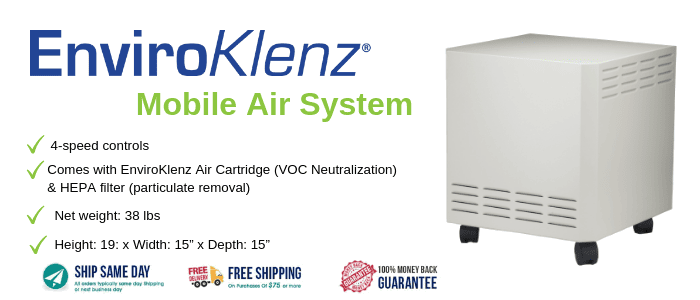
The EnviroKlenz Mobile Air System is your solution to removing VOCs and chemical pollutants from your indoor environment. With the use of a hospital-grade HEPA filter and an effective earth mineral technology air cartridge, this two-stage filtration is perfect to place in your indoor space to mitigate potential hazards to your health. Whether you have chemical sensitivities, allergies, or are just looking to improve your indoor air quality, the EnviroKlenz Mobile Air System is your answer!
- Simple and Easy to Set-Up, with Minimal Maintenance
- Replace Air Cartridge every 4 to 6 Months
- HEPA Filter Replaced Every Two Years
- Quiet Operation, 4-Speed Motor
- No Chemical Odors Released!
We are confident that our EnviroKlenz Technology will drastically reduce the odors in your home, if it doesn’t live up to your expectations, we will issue a full refund within 30 days of your purchase!
Click below to buy NOW!

